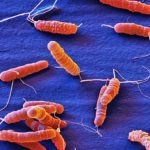Link to Pubmed [PMID] – 12180933
Mol. Microbiol. 2002 Aug;45(4):1165-74
Urea uptake in eukaryotes and prokaryotes occurs via diffusion or active transport across the cell membrane. Facilitated diffusion of urea in both types of organisms requires a single-component channel. In bacteria, these transport systems allow rapid access of urease to its substrate, resulting in ammonia production, which is needed either for resistance to acidity or as a nitrogen source. In Yersinia pseudotuberculosis, a ureolytic enteropathogenic bacterium, a gene of unknown function (yut) located near the urease locus was found to encode a putative membrane protein with weak homology to single-component eukaryotic urea transporters. When expressed in Xenopus oocytes, Yut greatly increases cellular permeability to urea. Inactivation of yut in Y. pseudotuberculosis results in diminished apparent urease activity and reduced resistance to acidity in vitro when urea is present in the medium. In the mouse model, bacterial colonization of the intestine mucosa is delayed with the Yut-deficient mutant. Although structurally unrelated, Yut and the Helicobacter pylori UreI urea channel were shown to be functionally interchangeable in vitro and are sufficient to allow urea uptake in both bacteria, thereby confirming their function in the respective parent organisms. Homologues of Yut were found in other yersiniae, Actinobacillus pleuropneumoniae, Brucella melitensis, Pseudomonas aeruginosa and Staphylococcus aureus. The Y. pseudotuberculosis Yut protein is therefore the first member of a novel class of bacterial urea permeases related to eukaryotic transporters.

